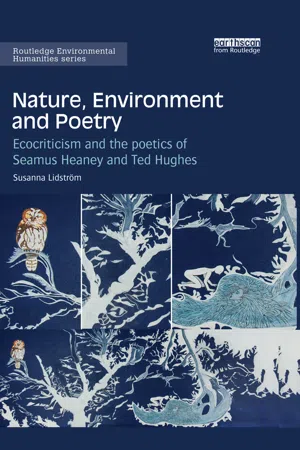
Nature, Environment and Poetry
Ecocriticism and the poetics of Seamus Heaney and Ted Hughes
Susanna Lidström
- 162 pages
- English
- ePUB (adapté aux mobiles)
- Disponible sur iOS et Android
Nature, Environment and Poetry
Ecocriticism and the poetics of Seamus Heaney and Ted Hughes
Susanna Lidström
À propos de ce livre
The environmental challenges facing humanity in the twenty-first century are not only acute and grave, they are also unprecedented in kind, complexity and scope. Nonetheless, or therefore, the political response to problems such as climate change, biodiversity loss and widespread pollution continues to fall short. To address these challenges it seems clear that we need new ways of thinking about the relationship between humans and nature, local and global, and past, present and future. One place to look for such new ideas is in poetry, designed to contain multiple levels of meaning at once, challenge the imagination, and evoke responses that are based on something more than scientific consensus and rationale.
This ecocritical book traces the environmental sensibilities of two Anglophone poets; Nobel Prize-winner Seamus Heaney (1939-2013), and British Poet Laureate Ted Hughes (1930-1998). Drawing on recent and multifarious developments in ecocritical theory, it examines how Hughes's and Heaney's respective poetics interact with late twentieth century developments in environmental thought, focusing in particular on ideas about ecology and environment in relation to religion, time, technology, colonialism, semiotics, and globalisation.
This book is aimed at students of literature and environment, the relationship between poetry and environmental humanities, and the poetry of Ted Hughes or Seamus Heaney
Foire aux questions
Informations
1 Ecotrickster
This period was characterized by growing receptivity to the religious beliefs and practices of indigenous and Asian peoples at the same time that many were rejecting mainstream Western religions. Fused with intensifying environmental alarm, this religion-related ferment provided fertile cultural ground for a robust debate about the relationships between people, religion, and nature.(2010: 8)
There are now quite a few writers about who do not seem to belong spiritually to the Christian civilisation at all. In their world Christianity is just another provisional myth of man’s relationship with the creator and the world of spirit. Their world is a continuation or a re-emergence of the pre-Christian world … it is the little pagan religions and cults, the primitive religions from which of course Christianity itself grew.(‘Ted Hughes and Crow: An Interview with Ekbert Faas’, in Faas, 1980: 205)
Crow the trickster
The Trickster myth is found in clearly recognizable form among the simplest aboriginal tribes and among the complex. We encounter it among the ancient Greeks, the Chinese, the Japanese and in the Semitic world. Many of the Trickster’s traits were perpetuated in the figure of the mediaeval jester, and have survived right up to the present day in the Punch-and-Judy plays and in the clown. Although repeatedly combined with other myths and frequently drastically reorganized and reinterpreted, its basic plot seems always to have succeeded in reasserting itself.(1956: p. ix)
[he is] at one and the same time creator and destroyer, giver and negator, he who dupes others and who is always duped himself. He wills nothing consciously. At all times he is constrained to behave as he does from impulses over which he has no control. He knows neither good nor evil yet he is responsible for both. He possesses no values, moral or social, is at the mercy of his passions and appetites, yet through his actions all values come into being.(1956: p. xi)
Nature writer David Quammen has [suggested] that the natural intelligence of crows is far in excess of what is demanded for survival in their biological niche. The result is that they are continually bored and make up games to amuse themselves.(2003: 8, 19)
a crow once invited his friend the hawk to dinner. Though the fastidious raptor would eat only freshly killed meat, the crow served him a greasy bullsnake that had already begun to decay. The hawk politely pretended to eat and even complimented the crow on his culinary art, while secretly plotting revenge. Soon afterwards, the hawk invited the crow to dinner, and he served a putrid dish concocted from the skin and entrails of rabbits. Instead of turning away in disgust, the crow avidly devoured the meal, leaving the hawk more infuriated than ever.(2003: 92, 98–9)
Table des matières
- Cover Page
- Half-Title Page
- Series
- Title Page
- Copyright Page
- Table of Contents
- Acknowledgements
- Introduction
- 1 Ecotrickster: environment and nature religion in Crow
- 2 Human history and environmental time: postmodern nature in Heaney’s bog poems
- 3 Technology and landscape: counter and recovery poems in Elmet
- 4 Colonised nature: Heaney and postcolonial ecocriticism
- 5 Ecosemiotics: anti-anthropocentrism in Hughes’s animal poems
- 6 ‘The place in me’: Heaney, globalisation and sense of place
- Conclusion: Hughes, Heaney and the different natures of ecopoetics
- Index